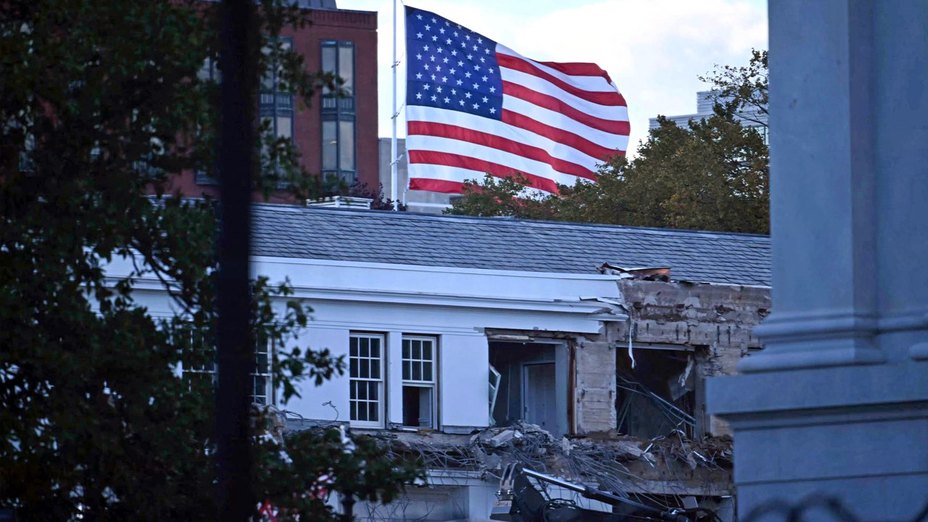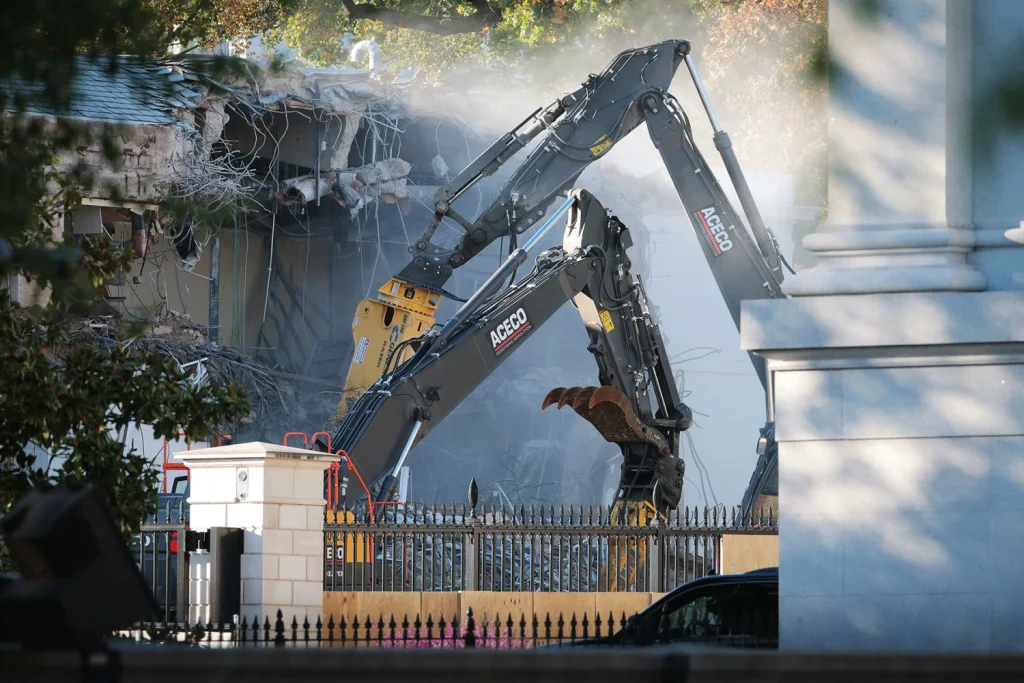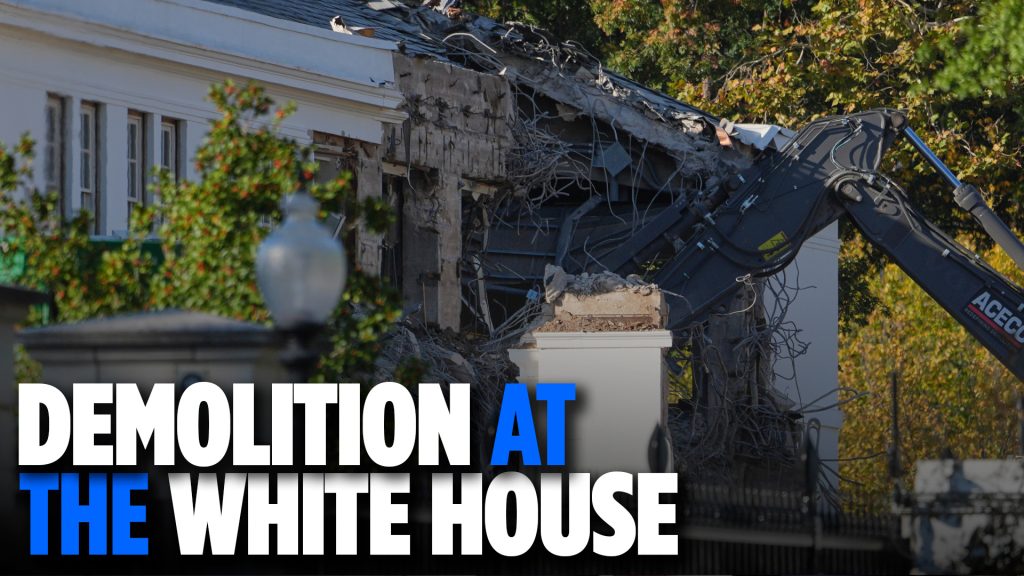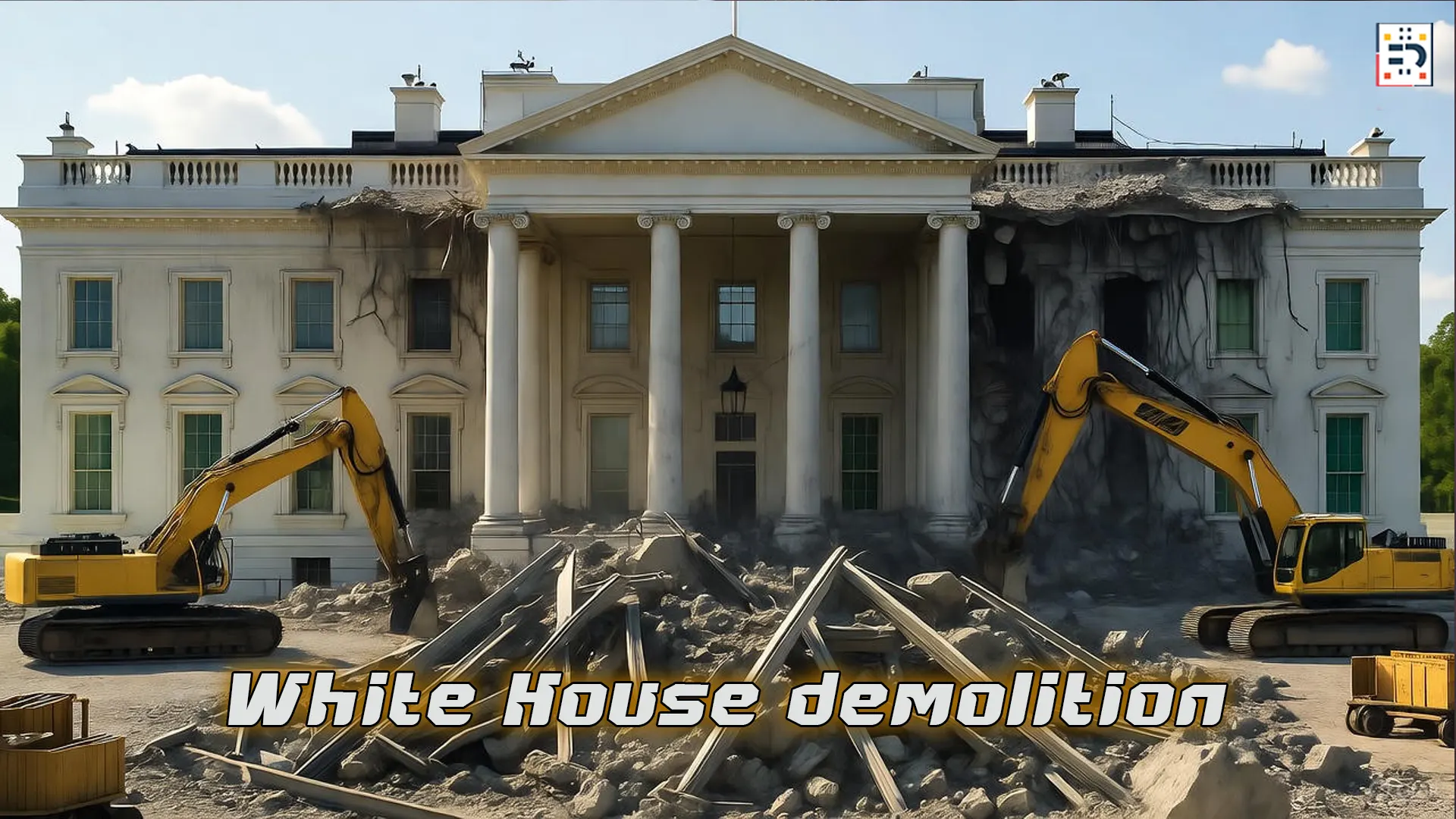White House Demolition Shocks Nation: Trump’s Historic Ballroom Project Underway
Washington, D.C. – Demolition crews shocked Americans on Monday, October 20, 2025. They began tearing down portions of the historic White House East Wing. President Donald Trump’s controversial $250 million ballroom project has officially started.
This White House renovation 2025 marks the biggest architectural change since the 1950s Truman reconstruction. The project has sparked intense debate nationwide about historical preservation versus modernization.
Latest News: East Wing Demolition Captured on Camera
Construction crews photographed the dramatic demolition Monday afternoon. They systematically dismantled the White House East Wing facade. This wing has served as the First Lady’s office headquarters for decades.
Backhoes tore through windows, walls, and roofing. The dramatic images went viral across social media platforms within hours. Major news outlets picked up the story immediately.
The Washington Post and CNN reported on the scene. Secret Service officials watched from the adjacent Treasury Department building. White House correspondents documented the historic moment. Heavy machinery sounds echoed across the complex throughout Monday.
President Trump confirmed the White House construction start date via Truth Social. He stated he felt “proud to announce” that work had officially begun. During an LSU baseball team celebration in the East Room, Trump acknowledged the construction. He told attendees, “We have a lot of construction going on, which you might hear periodically. It just started today.”

Trump White House Ballroom: Design Details and Specifications
The planned White House ballroom expansion will create a massive venue. The space measures 90,000 square feet. Architectural sources suggest the final footprint may grow even larger.
Designers plan to accommodate between 650 and 999 guests. This dramatically exceeds the East Room’s current 200-person capacity.
Ballroom Architectural Features
The White House Communications Office released architectural renderings. The design showcases opulent neoclassical features:
- Gold and crystal chandeliers illuminate the entire ballroom space
- Gilded Corinthian columns support the elegant structure
- Coffered ceilings with gold inlays feature ornate detailing
- Checkered marble flooring creates a classic black and white pattern
- Three walls of floor-to-ceiling arched windows overlook the South Grounds
- Design elements echo the main residence’s classical architecture
President Trump has consistently advocated for this White House modernization project. He claims U.S. presidents have wanted a grand ballroom for over 150 years. Trump has expressed frustration with temporary pavilions on the South Lawn. These structures perform poorly during bad weather.
“When it rains or snows, it’s a disaster,” Trump told reporters during a White House briefing earlier this year.
White House Demolition Controversy: Conflicting Statements
The East Wing demolition has generated significant controversy. Trump made specific promises in July 2025. He said the ballroom project “won’t interfere with the current building.” He claimed builders would construct it “near it but not touching it.”
Critics point to Monday’s demolition work. They say it directly contradicts these earlier public assurances. Architectural preservationists have raised concerns.
White House Press Secretary Karoline Leavitt spoke in July. She stated “nothing will be torn down.” She later clarified her statement. East Wing offices will relocate temporarily. The wing will undergo “full modernization and renovation.”
Federal Approval Questions
The White House construction project proceeds without formal approval. The National Capital Planning Commission typically oversees major construction on federal property. The commission has not yet approved this project.
The White House maintains a specific position. They claim they only need approval for new vertical construction. Demolition and site preparation don’t require commission approval.
Will Scharf chairs the commission. He also serves as a senior Trump aide. Scharf stated during a September 2025 meeting that the agency handles “vertical build” rather than demolition. Politico reported his comments.

White House Ballroom Funding: Private Donations and Corporate Sponsors
The Trump administration insists the White House renovation project uses zero taxpayer dollars. Private funding covers all costs. This serves as a key defense against criticism.
Major Corporate Donors
Disclosure statements reveal major technology corporations have pledged funding:
- Apple Inc. pledged $5 million
- Microsoft Corporation pledged $5 million
- Coinbase pledged $5 million
- Multiple Fortune 500 companies pledged $5 million or more each
President Trump confirmed he will personally contribute to the White House ballroom cost. He has not disclosed specific amounts.
The project budget has grown significantly. Initial estimates placed costs at $200 million. The current price tag stands at $250 million. Trump confirmed this figure at a private donor dinner last week.
Construction Timeline
White House officials have committed to a completion date. They plan to finish the ballroom construction before January 2029. This gives builders approximately three years.
Construction management sources call this timeline aggressive. The project’s scope presents significant challenges. Building on White House grounds adds complexity.
Historical Context: White House Architecture and Previous Renovations
The White House demolition 2025 requires historical context. President Theodore Roosevelt commissioned the East Wing in 1902. President Franklin D. Roosevelt added a second story in 1942.
Truman Reconstruction Comparison
White House Communications Director Steven Cheung defended the demolition. He referenced the extensive Truman-era reconstruction. He shared historical photographs on X (formerly Twitter).
The entire White House underwent complete reconstruction from 1948-1952. Structural engineers discovered critical problems. They found the building “structurally weak and in danger of collapse.” The White House Historical Association documents this period.
“Construction has always been a part of the evolution of the White House,” Cheung wrote. He added, “Losers who are quick to criticize need to stop their pearl clutching.”

Architect’s Vision
James McCrery serves as CEO of McCrery Architects. He designed the project. McCrery stated his position when the ballroom was announced. “Presidents in the modern era have faced challenges hosting major events at the White House,” he said. The building “has been untouched since President Harry Truman.”
McCrery expressed honor in the assignment. He aims to “bring this beautiful and necessary renovation to The People’s House.” He pledges to preserve “the elegance of its classical design and historical importance.”
Public Reaction to White House Demolition: America Divided
The White House demolition news generated intense reactions immediately. Social media platforms erupted with commentary. Traditional news outlets covered the story extensively. Demolition photos went viral within hours.
Critics’ Concerns
Opponents of the White House renovation have raised several concerns:
- Historical preservation – Critics question demolishing a 120-year-old structure
- Timing and optics – The project coincides with economic concerns
- Transparency issues – Federal approval is lacking and statements conflict
- Design appropriateness – Many believe gilded design conflicts with historic character
NBC News and ABC News highlighted criticism from experts. Architectural historians question the project. Preservation advocates raise concerns. The White House holds National Historic Landmark status.
Supporters’ Arguments
Proponents of the Trump ballroom project offer counterarguments:
- Necessary modernization – Current White House event capabilities lag behind needs
- Private funding – Taxpayers pay nothing for the project
- Presidential legacy – Future administrations will benefit for generations
- Diplomatic importance – Enhanced hosting abilities for international dignitaries
The White House Historical Association founded under First Lady Jacqueline Kennedy. The organization’s mission focuses on protecting and preserving the Executive Mansion. They have not issued an official public statement about the demolition.
White House Construction Updates: What’s Next?
The White House demolition 2025 now progresses into full-scale construction. Several key questions remain unanswered.
Upcoming Milestones
- Complete demolition phase – Expected by late November 2025
- Foundation and structural work – Winter 2025 through Spring 2026
- Vertical construction – Summer 2026 through Fall 2027
- Interior finishing – Throughout 2028
- Final completion – Targeted for late 2028 or early 2029
Monitoring and Oversight
The National Park Service maintains the White House grounds. The General Services Administration oversees federal buildings. Both agencies will play ongoing roles in project oversight. Specific arrangements have not been publicly detailed.
Historic White House Transformation Continues
The White House demolition and construction project represents a watershed moment. America’s most symbolically important building faces dramatic change. Demolition crews tear through the East Wing. Construction begins on the massive ballroom addition.
The nation watches with mixed emotions. Fascination, concern, and anticipation blend together. Some view this as necessary modernization. Others see controversial alteration of a national treasure.
The Trump ballroom project will leave a lasting architectural legacy. It will impact political discourse for years. The completed structure will serve future presidents. It will host historic events for generations. This assumes builders meet the ambitious three-year timeline.
Check back regularly for breaking news and developments about White House construction 2025.
Frequently Asked Questions (FAQ)
Q: When did White House demolition start?
A: Demolition began on Monday, October 20, 2025.
Q: How much does the Trump White House ballroom cost?
A: The project costs $250 million. Private funding covers all expenses.
Q: When will the White House ballroom be completed?
A: The White House targets completion before January 2029.
Q: Is taxpayer money being used for White House renovation?
A: No. The administration states the project is 100% privately funded.
Q: How big is the new White House ballroom?
A: The ballroom measures approximately 90,000 square feet. It accommodates 650-999 guests.
Q: What is being demolished at the White House?
A: Builders are demolishing the East Wing. They originally constructed it in 1902.
#WhiteHouseDemolition #TrumpBallroom #WhiteHouse2025 #EastWingDemolition #WhiteHouseConstruction #BreakingNews #WashingtonDC #USAPolitics #Trump2025 #PresidentialNews #WhiteHouseRenovation #ConstructionNews #HistoricBuilding #PoliticalNews #USANews


